
22 minute read
Business Profile We meet Lee Grabham and Wayne Smith, founders of SIBA’s Brewery Business of the Year, Brew York
Issue 10 Summer 2022
Brew York state of mind

Brew York state of mind
Cover Story
Brew York’s Founders Lee Grabham and Wayne Smith were first introduced by a mutual friend at a stag do in Germany in 2014, where they bonded over a shared passion for craft beer. Later meeting up at a BBQ, the pair embarked on some serious homebrewing, before a chance train of events in 2016 led to both of them being offered voluntary redundancy from their respective jobs at the same time. The duo took the plunge into full time brewing, locating a great site in central York with a riverside space perfect for the taproom they had planned. They soon outgrew the original site, taking on the three-story building next door before searching for their first additional site outside York. This turned out to be in nearby market town Pocklington, after local brewery Hop Studio decided to sell its taproom. The sale also included the Hop Studio brewery site to the north of York city centre – a larger operation than the original Brew York site and perfect for expanding the business. Another retail site in Leeds, opened during the pandemic, completes the current business model, although there are plans to expand the retail arm further when the opportunity arises. All this expansion – a doubling of production volumes – has meant that Brew York has achieved amazing commercial results over the last year, an accomplishment that has not gone unnoticed, with Lee and Wayne taking to the stage at BeerX in March to collect not one, but two SIBA Business Awards – Commercial Achievement and overall SIBA Brewery Business of the Year for 2022. Independent Brewer’s Editor Caroline Nodder jumped on a Zoom with them both in May to find out more about the business, and the pair were characteristically modest about their awards success, although extremely proud of the incredible and rousing reception they received from their peers in the room on the night…
Business Basics

Name: Brew York Founded: 2016 Location: York (two brewery sites) & York, Leeds and Pocklington, East Riding of Yorkshire (retail sites) Owners: Lee Grabham & Wayne Smith Annual production: 12,500hl (estimated 2022) & 8-9,000hl produced in 2021 Brewing team: 12 Staff: 68 (including retail) Core beers: Calmer Chameleon (3.7% ABV American Pale Ale), Golden Eagle (4.8% ABV Pilsner), Haze of Thunder (4.2% ABV Modern Pale Ale), Tonkoko (4.3% ABV Milk Stout), Juice Forsyth (5% ABV Juice Bonus Fruited IPA), Lupu Lion (GF) (5% ABV American Pale Ale) & Rhubarbra Streisand (5.5% ABV Rhubarb Milkshake Pale) Production split: 20% cask, 40% keg & 40% can Key export markets: Biggest market is Asia but 20 different territories in total (5% of overall business)
How did you both get into brewing and how did the idea for Brew York come about?
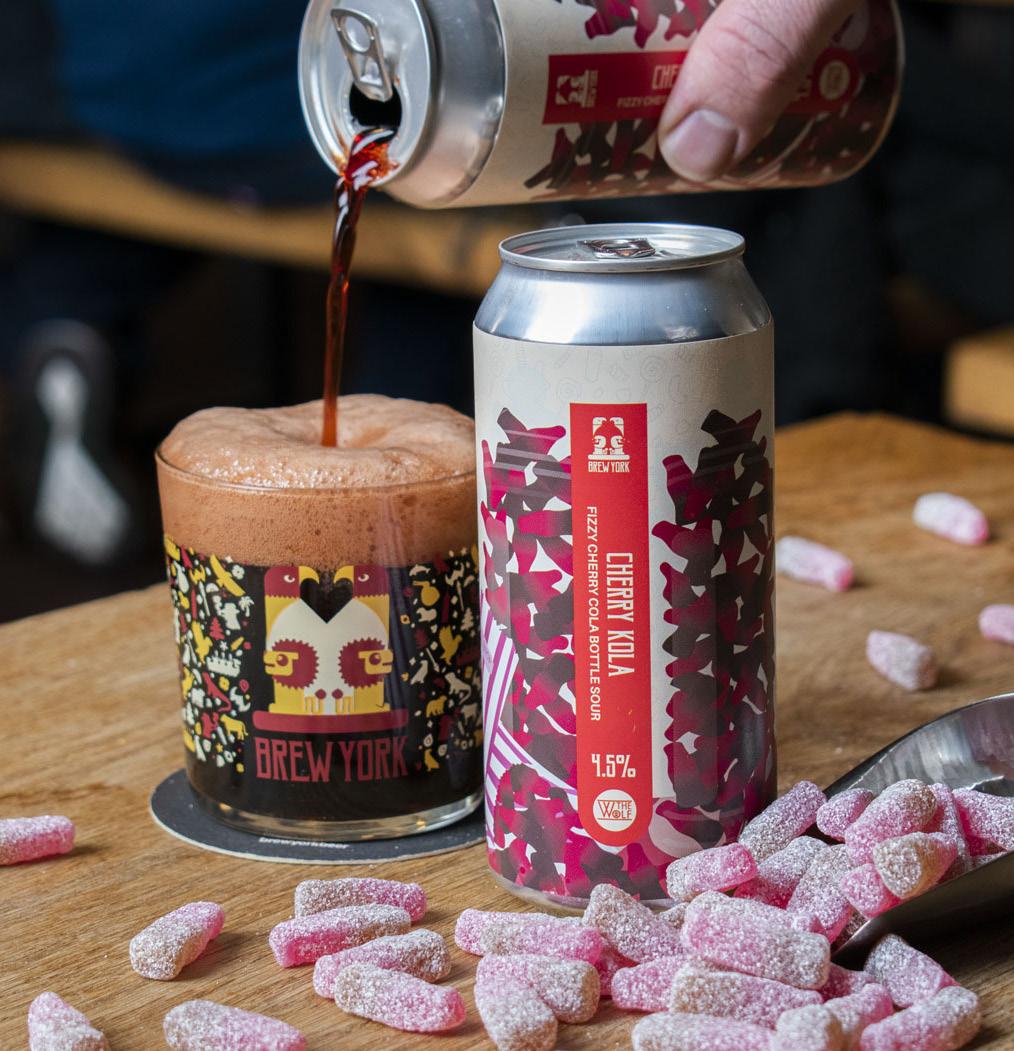
WS: “So going back to, probably, 2014 I think it was, one of the guys who used to work for me in my previous career as a finance director, we went on a stag do to Hamburg and I met Lee at that stag do - both drinking lager and talking about how we missed being in the UK and drinking beer! We had a lot in common from that point onwards. And then when we were back in the UK, I'd taken up homebrewing. So I was at the same friend's barbecue and I took some homebrew round and everyone really enjoyed it. Lee had done some homebrew with his dad when he was younger and I happened to have some extra equipment at the time and I sold that to Lee and he started brewing in his shed. Then we started brewing beer together and entering local competitions and things were going well. And an opportunity came up at work where I was at the time - another business had bought the business I was working for - so I spoke to my boss to see if he'd let me take voluntary redundancy. At the time Lee was working for quite a large company that also regularly went through restructuring exercises.” LG: “My company bought another one, so both our companies were looking to reduce the headcount and so we were like, ‘Please sir, can I go?’” WS: “It was a big change because both of us had successful careers in what we were doing. But we were a bit bored. And I think we both went down the pub and just said, ‘Well, this type of opportunity is not going to come along again, worst case scenario, it doesn't work. And we go back to what we used to do. But best case scenario, we can actually do something we love for a living.’ So thankfully, the best case scenario came to fruition after many, many years of ridiculously long hours and hard work. It doesn't feel as much like work when you love doing it.”
How has the business developed since it launched?
WS: “At that point in time, there wasn't that much going on in the beer scene in York. I don't mean that in a disrespectful way. There was York Brewery at the time who were a much more traditional brewer, who had some really good pubs in the city, but that was compared to other cities like Leeds, Manchester, London, where the craft beer thing was really kicking off and taprooms were cropping up. There was nothing like that in York. And just luckily, while I was scanning the local lease availabilities, there was a large warehouse within the city walls. It felt like it was far bigger than we needed, but when we went to see it and saw the rear riverside terrace, we thought it would make an amazing taproom. And even if it was too big for the brewery size we were looking at, I figured we might eventually grow into it." LG: “I would say, even at that point, friends in the brewing industry told us, it would not be too big, and to always make sure you get somewhere bigger than you think you need, you will fill it. And inside three years we had. I think beyond the craft beer or craft gin industry, nobody's looking to do industry in city centres anymore. The access is terrible. The utilities are terrible. It's impossible to upgrade things. So only if you can accommodate some form of industry with retail space, does it actually make sense. And that's what we wanted. We'd visited many taprooms around the country - a big favourite of ours was Magic Rock - but they were always that little bit further out of the city on an industrial complex. We wanted something central where we could have two thirds brewery space and one third taproom.” WS: “At the time when we put the business plan together, competition was already pretty fierce in the craft beer industry. And part of the plan was looking at the fact that, it doesn't matter how good the beer is, if we can't get it into someone's hands to drink. So, first and foremost, we needed great beer, then secondly we needed branding that caught people's eyes to make them pick it up and drink it. And then thirdly, a great location, so that if we can’t get people to buy our beer elsewhere, they can come and try it at our site, then hopefully, word would grow from that. And with hindsight, again, that was a great thing. Having this city centre taproom meant that cashflow was always relatively good for us. Because once we got the taproom up and running and it became popular, that was a big proportion of our sales. A lot of breweries struggle with growth because they can't raise the cash. And people won't necessarily invest in them at an early stage, whereas we managed to grow relatively rapidly from having access to reasonable cashflow. But then, because we have the great location, randomly, we had a couple of beer buyers come on our brewery tour in the early stages. And we ended up with listings in both Tesco and Asda within our first year. This was before selling in supermarkets was cool again, we weren't allowed to do this! We were one of the ones who learned a lot from it.”
LG: “We killed a couple of brands.” WS: “The scale we were at back then we soon realised we couldn't keep up with demand from the independents so we parked the supermarkets because it wasn't the most profitable way of selling our beer, and then grew the independent side of the business. Looking back at it now, it was the right thing for us to do at that point in time, but it was then, and it still is, very hard to get back into supermarkets now.”
Continued on page 35
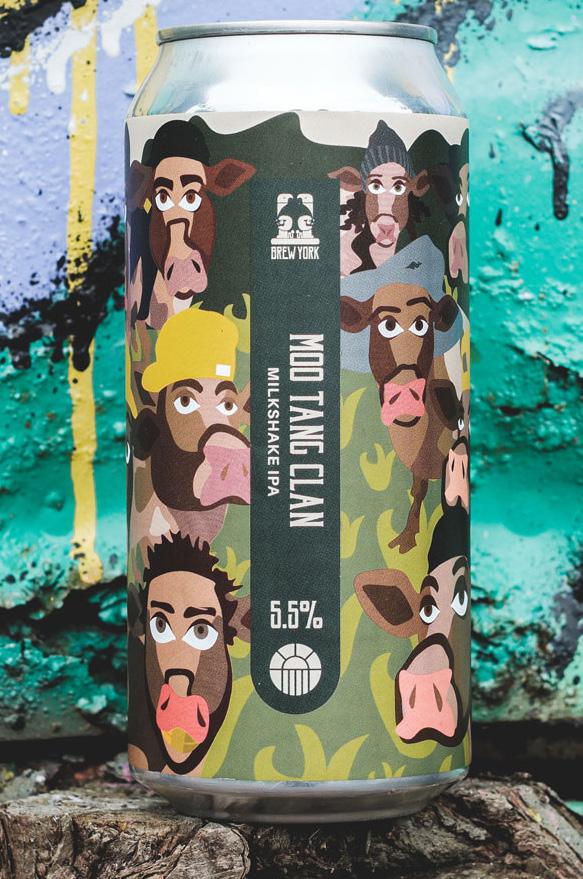
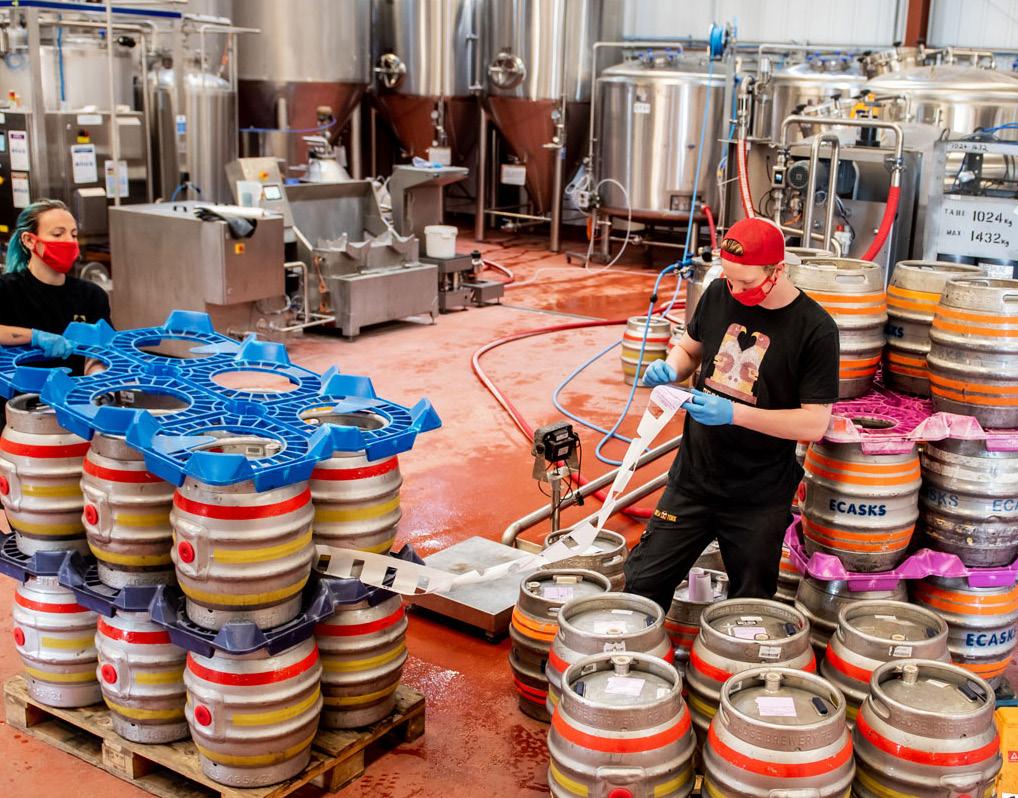
LG: “Fairly soon into our history in the centre of York, it became evident that we were going to run out of space quite quickly. We were on friendly terms with our neighbours and with our landlord, and it became apparent that the building next door was going to become vacant. So in the first instance, we took on the lower ground floor of it for additional storage, and it's actually ended up being partly storage and partly an offshoot of our taproom – there’s a bit of an event space. Then some months after that, we were then offered the opportunity to take the remaining floors. And we built a huge 60 beerline, German style beer hall with integral street food kitchen. So between the taproom, beerhall and expanded front yard that we created, and rear riverside garden, we now have a capacity of about 450 people. On a Saturday, it's standing room only.” WS: “We realised that the popularity was there and it's probably time to start looking for a first out of town opportunity. There happened to be another brewery in the area called Hop Studio, who were on the outskirts of York. And they were in the process of selling their brewery and the Taproom bar that they built in an adjacent village, Pocklington.” LG: “It wasn't what we were looking for. We were thinking Leeds, Manchester, some sort of big urban centre, but this just seemed too good to be true. So we went with a market town as our first foray out of York city centre.” WS: “This was in January 2020. So we got maybe three months trading before Covid hit which was difficult because we were getting really good momentum and making good progress. But we continued to use that venue as a bottle shop and we kept up our presence there. It was hard work, but the venue didn't lose money, which was great. We moved a lot towards our online store, and as soon as we felt that we weren't going to go out of business and we could still continue growing we started looking at what opportunities might arise in different markets like Leeds and Manchester. So we actually went across and we found a venue in Manchester we actually put an offer in on it. And a new venue came on the market in Leeds and we put an offer in on that one as well. Restrictions hit again and everything locked down again. So we ended up pulling out of the one in Manchester because it just felt like too much to do. Whereas the Leeds one was pretty much ready to go. So we eventually got that place opened a year ago.”
The most pleasing thing was not just to win it, it was to see how it was celebrated in the room. It felt like a popular win. It felt like people, our peers, were happy that we had won.”
You recently won the Commercial Achievement Award and were named Brewery Business of the Year at the SIBA Business Awards, what impact has that had?
LG: “If we start with a commercial hat on, we didn't imagine there would be too many businesses that managed to grow in the economic turmoil we've had over the last year. So we probably thought we had a reasonable shot at the Commercial Achievement Award. Not in our wildest dreams did we expect Brewery Business of the Year. But the most pleasing thing was not just to win it, it was to see how it was celebrated in the room. It felt like a popular win. It felt like people, our peers, were happy that we had won.” WS: “We’re quite…ambitious isn't really the word I’d used to explain it…but we’re quite driven. We like to get our heads down and get on with what we're doing. So we don't tend to reflect very often on what we've managed to achieve. And people always say to me, ‘you must be really pleased with how things are going’. But we've never really reflected on that. So it was only when we started putting the business case together for the Commercial Achievement submission - I knew just how hard everyone had worked for the last two years in particular, because we pretty much doubled in size overnight, not just the size the brewery, but the volume of output went from 5,000hl to 9,000hl. And it wasn't a gradual journey. So it was such a big step change. There's lots of hard work from the whole team, lots of challenges to overcome and a new site. So it was just really nice to be able to sit down, look at what we had all done together. And when you see it down on paper, you're like, ‘Wow! We have done a lot in this period’. And that's great to see, to get the recognition and to give everyone a pat on the back and just say, ‘Good work, guys!’”.
What is the ethos behind the business and the beers you produce?
WS: “What we set out to do is brew beer that we enjoy, to be creative and brew things that are really interesting and that make people want to try beer.” LG: “It's evolved since, but the thing we said right at the start, was we're going to make beer that we want to drink and we're going to build places in which we want to drink. That's how it started out and it's evolved since and a big part of what we do these days is about constantly wanting to innovate and be on the forefront of whatever the UK beer scene is. Not always trying to follow our American cousins and trying and do a little bit of our own thing as well. Then I suppose the final bit which we have as part of our company vision and values is the word ‘fun’. It's a business, yes. But hopefully it can be seen in our branding that we are about having fun.”
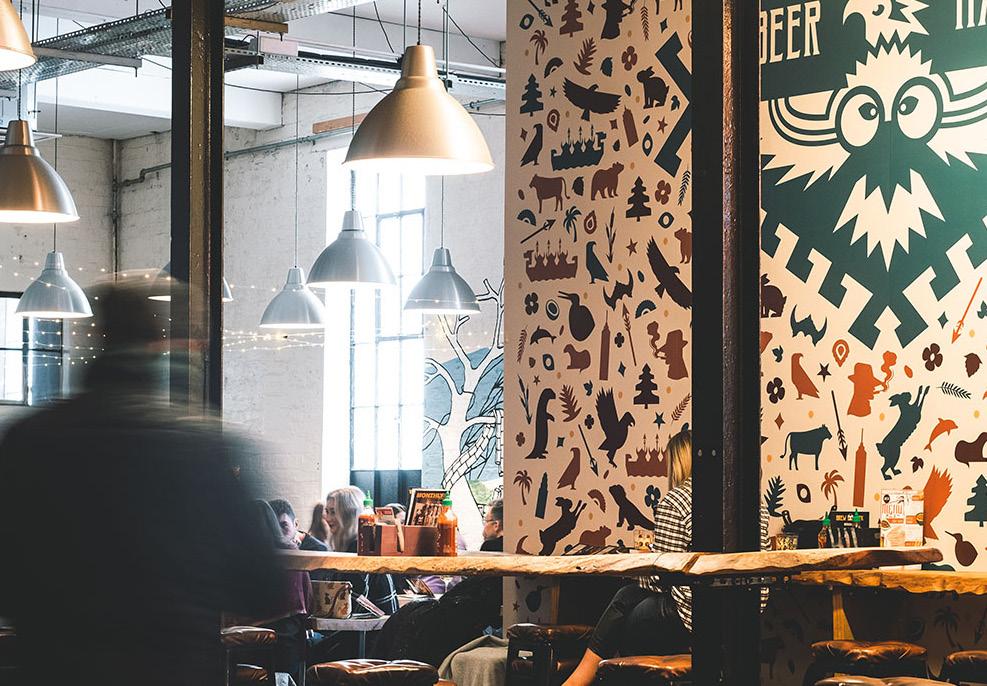

How do you differentiate yourselves in such a crowded market?
WS: “I think the innovation and the creativity is a big part of it. So if you come visit us at a beer festival, there's usually a good variety of beer on and we don't see it as quantity over quality, we like to feel that every different beer style that we put our minds to, we try and brew the best version of that style we can. So we're not going to knock some of these top tier breweries out of the park with our hoppy IPAs, or hazy pales. But we're not going to be far off the quality. But then we're confident in the stouts, we make some of the best in the world, the sours, the different styles we can do, we can do very, very well.”
LG: “We never wanted to be a one trick pony. I think the fact that we get to constantly innovate and try and identify ingredients that we've not worked with yet, and then work out the way in which they need to be used. Just always keeping an eye on things that are going on in Scandinavia, things that are going on in the US, what is going to be the next big trend.”
How are you tackling sustainability at Brew York?
WS: “As soon as we moved on to this site, one of the first things we started looking into was solar power because we have such a huge footprint on the rooftop – it’s huge, we’ve got 28,000 square feet of roof. Unfortunately, one of the main companies we were going to use went out of business. And we then had to be relatively selective about capital investments. We're still going to pick this up though especially with the way energy pricing has gone recently. The other thing given the size of the warehouse and the storage we have, is we're moving a lot more of our beer into steel, which is reusable and has less of an environmental impact. We also found a local business that recycles all our aluminum cans now.” LG: “Longer term, there's a project at York University where they're attempting to convert our spent grain into mugs and drinking vessels. So conceivably, at some point, you might be able to drink a Brew York pint out of a spent grain recycled pint pot!”
How have you reacted to the ongoing reports of sexism and issues with inclusivity and toxic culture within some craft breweries?
WS: “We were fortunate enough that from our corporate days, we had a lot of contacts who were in a similar position to us, and wanted to do something that they found more enjoyable than the nine to five in the office. A lady called Alison used to work in our bars on the weekend just to do something different. And as soon as we could afford to bring her on board, we brought her into the team as HR director. So she's always been around to help steer and guide us on human resource related issues. We've also then been quite open to trying to listen to our team and hearing feedback on what works, what doesn't work.”
LG: “We've had policies in place since almost the get go. And people know how they would report such things. We're just rolling out sexual harassment training right now, in much greater depth than we've ever done it before. Obviously, we don't have an issue, but you never know.” WS: “We try to engage, and facilitate participation in any scheme that educates people on the issue and what things we can do better. Women on Tap is a project which is coordinated by Rachel Auty, who's based in Harrogate. It's a two week programme of events to try and educate people and empower women in the industry, and also just make it a better working environment. We've sponsored that for the last three years. And we've had a lot of input from our production team, as well as our marketing team, in trying to engage as much as possible. So we brewed their official beer this year. And Nadia, who was one of our apprentices, led the brew and actually brewed a beer for the first time, which is really, really good to be involved in. Just prior to the brew, she did get a promotion.” LG: “We took her off the apprentice programme, eight months early, and have appointed her as an assistant brewer, she led the brew and she's brilliant, to be honest, just absolutely incredible. So much enthusiasm.”
What main challenges are you facing right now as an independent brewery?
WS: “All the costs have gone up this year. So our rent and rates are going up, our utility costs are going up, CO2, raw materials, ingredients, all these things and we are fighting our hardest to actually put our pricing down so that people are still wanting to drink, technically, more expensive beer than they can get in a local pub. The volume of different ingredients we use and the volumes of fruit and the speciality ingredients means that the base cost for our beer is quite high. So we're just looking at any ways in which we can save money without compromising quality. And for us the biggest area where we've been able to do that is the packaging. The bigger site means we've been able to commit to bigger volumes of cans, which means we can save there, and the latest thing for us is moving to Close Brothers who have a new keg rental model called EkegPlus. All of these things mean we feel like we'll be able to help to at least hold our price, if not put them down to try and deter people from moving away from beer or drinking.” LG: “Other challenges include the external headache of quality, so the bigger you get, the less forgiving your consumer base is. So we've invested very heavily in analytical equipment, in things like an almost £100,000 centrifuge for clarification and stability of our product. A new canning line, which has the lowest level of oxygen pickup for a line of its type in the UK. All these things are constantly driving quality.”
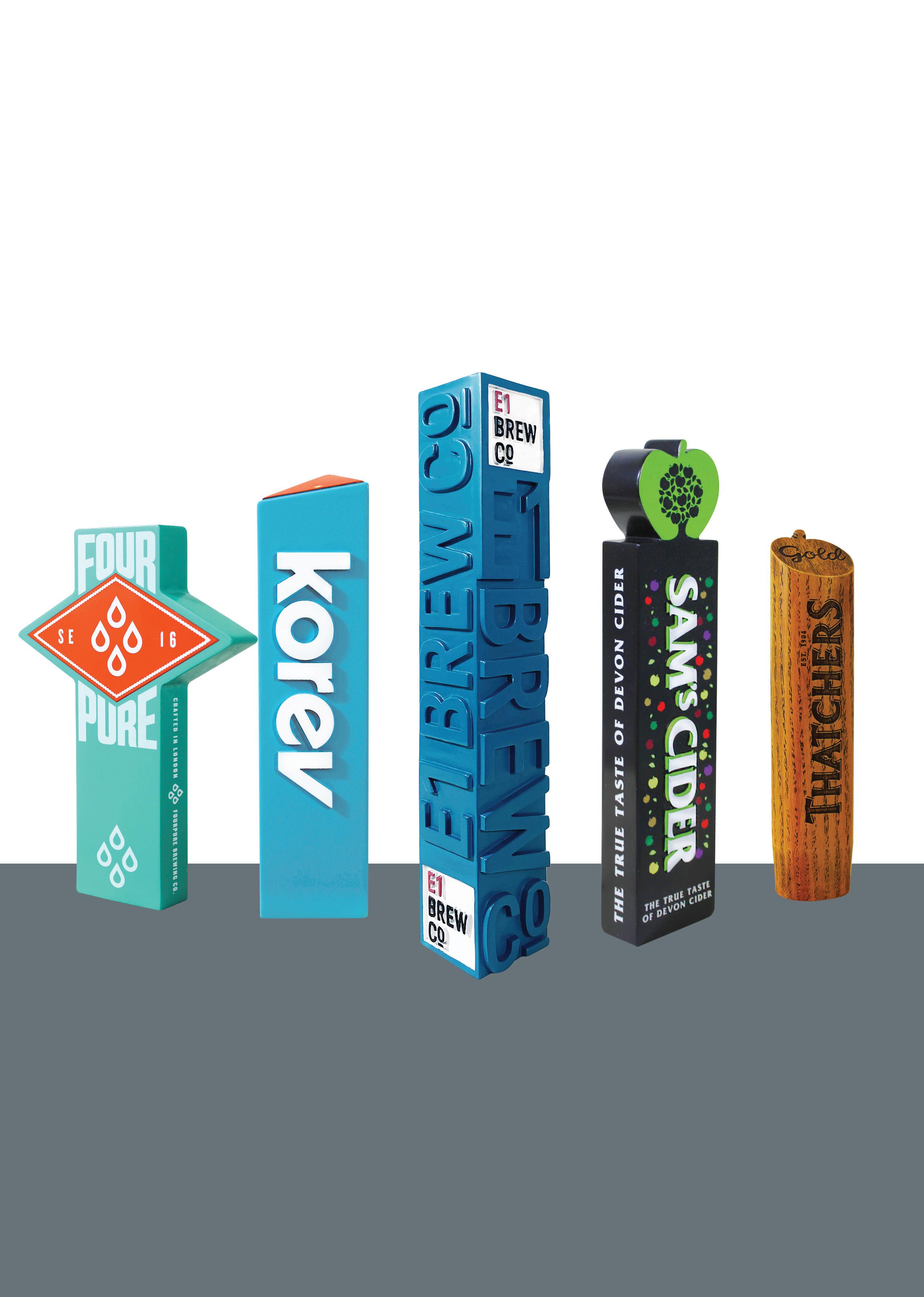

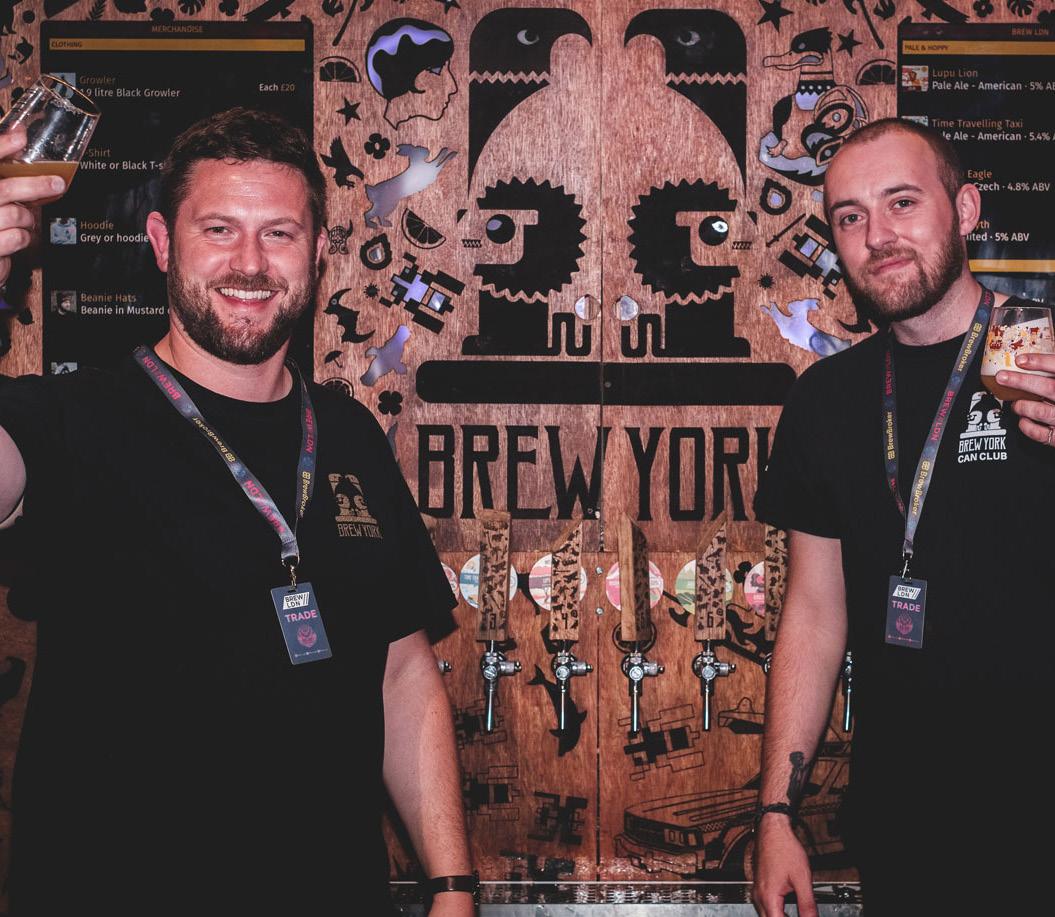
How do you see the UK craft brewing scene changing over the next few years?
WS: “I think there have been a volume of new breweries that have opened up in the pandemic, a lot of it was from the fact that people sat at home for at least a year, wondering about what they'd rather do with their careers. But I think it's getting much harder for some of those new startup breweries that are going to struggle and unfortunately some of them are going to go under. There's also sadly some well-established breweries that just aren't able to compete now, because of all the new breweries coming in, and possibly undercutting them, or just flooding the market with new and different beers, and they're now struggling to get their products out there.” LG: “I think the pandemic presented the perfect opportunity for any business in our sector to modernise, so if you've not taken the opportunity to do that through that period, then I would fear for you definitely.”
Are there any current trends in the beer world that particularly excite you?
LG: “There's one thing that's gone from being a trend to being fully embedded now, and that is the sour beer. I would say a couple of years ago, that was going to be the next thing. And it absolutely is now. We have really good sales of sour beer now and I mean, look at what Vault City have done. I heard the other day, they're the second biggest sour beer producer in Europe. I see sours as a big part of our future. I think it's attracted people across from cider, definitely.” WS: “One of the things that we've always wanted to do more of but we struggled because our water wasn’t good enough was lager. We didn't ever see it being something where we could compete in the UK with the likes of all the macro breweries out there who could knock lager out. But we always wanted it for our own venues because it's the most popular drink when people come in. So we brought a pilsner out when we got to the new site and got a water treatment facility. So we can make a great lager now, which, for us was all about just servicing our taproom. And then that's grown to independent venues who want a nice lager offering that's not necessarily a macro. That's been a growing trend in the UK, in terms of the craft lager scene for probably two and a half years.”
I would like our reputation, and our sales to expand internationally. I think we've done a reasonably good job in the UK. I'd like to be known beyond the UK now.
What are you proudest of during your time at Brew York?
WS: “For me, personally, it was the Brewery Business of the Year, winning that. It was just nice to put it all together and not just getting recognition for it, seeing how well we perform against our peers, but the peer recognition and support as well in the room was just amazing. Getting so many people that we look up to and respect patting us on the back and say well done, it was great.” LG: “I'd say two things. One is an extension of what Wayne said. For years, you have this kind of imposter syndrome. And there's these people that you've got on a pedestal and then you get to hear that they respect what you're doing. I think we're finally moving from imposter syndrome to maybe we belong here! And I would say also the scale to which we’ve grown the business, and I don't just mean that in terms of the financials or the amount of beer that's produced. I mean, the number of people that we employ - that's somewhere between 68 and 73 people that are dependent for their income, their livelihood, their families, on something that was just a concept six years ago.”
What plans do you have for the business over the next year?
WS: “We are trying to focus on what level of growth we think would work here without coming into too much scale. So we're aiming to move towards 30,000hl in the next few years. So that's where we'd like to get to and to get to that level we’d like to see growth in our core beer range, we’d like to see growth in export and we'd like to see more venues for our portfolio.” LG: “The big one for me is export. I would like our reputation, and our sales to expand internationally. I think we've done a reasonably good job in the UK. I'd like to be known beyond the UK now.”










